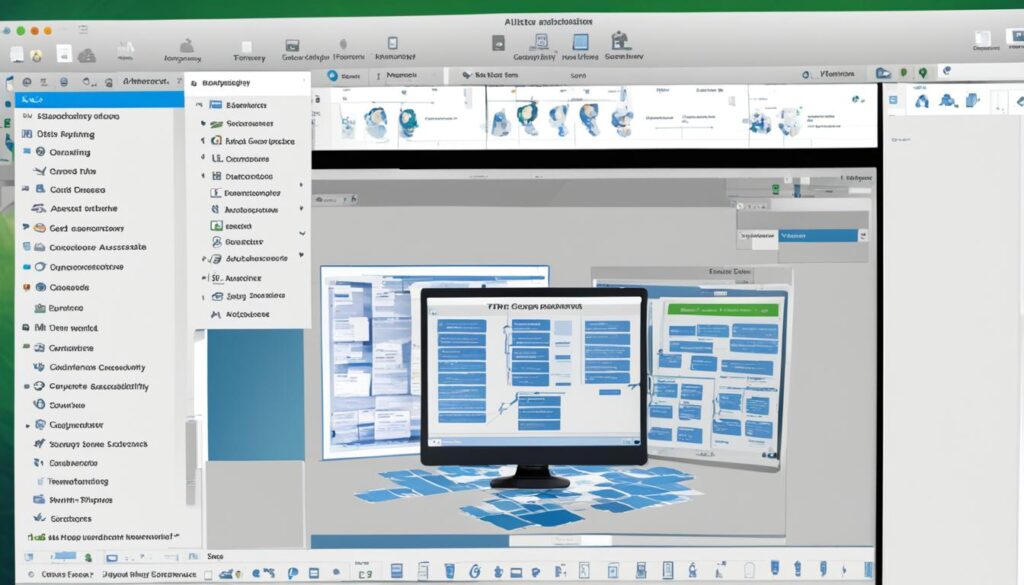In today’s world, researchers and professionals face a big challenge. They need to find important insights in a lot of qualitative data. ATLAS.ti is a great tool for both Windows and Mac users. It makes analyzing qualitative data easier.
ATLAS.ti is a full software package with many tools. It helps you find hidden patterns and connections in your data. You can organize your research, code, annotate, and visualize your findings easily with ATLAS.ti. It makes your analysis work smoother and more effective.
Key Takeaways
- ATLAS.ti is a leading qualitative data analysis tool for both Mac and Windows platforms.
- It offers a comprehensive suite of features to support various stages of the research process.
- ATLAS.ti empowers researchers, academics, and professionals to efficiently manage and analyze their qualitative data.
- The software’s intuitive interface and robust functionality make it a valuable asset for a wide range of disciplines.
- Discover how ATLAS.ti can streamline your qualitative research workflow and uncover deeper insights from your data.
Unleash the Power of ATLAS.ti for Mac & Windows
ATLAS.ti is a powerful tool for complex qualitative research projects. It works well on both Mac and Windows. It has many tools to help researchers and analysts get deep insights from different data sources.
ATLAS.ti can work with many types of data like text, audio, video, and images. This means you can mix and analyze various data in one place. It makes research easier and gives a complete view of the data.
The data analysis tools in ATLAS.ti are top-notch. They offer many features for exploring, coding, and understanding your data. You can find patterns and insights that were hard to see before.
ATLAS.ti is great for any project size. Its easy-to-use interface and customizable workflows are perfect for many fields. This includes academia, healthcare, market research, and more.
Using Mac or Windows, ATLAS.ti gives you a smooth experience. It doesn’t let platform issues slow you down. With its strong features and analytical power, ATLAS.ti changes how you do qualitative data analysis.
“ATLAS.ti has been an indispensable tool in my research arsenal. Its ability to handle diverse data sources and provide powerful analytical capabilities has truly transformed the way I approach my work.”
When starting your next qualitative research project, think about using ATLAS.ti for Mac and Windows. It can open up new ways to analyze data and find insights that move your research forward.
What is ATLAS.ti for Mac & Windows?
ATLAS.ti is a top tool for qualitative data analysis on both Mac and Windows. It helps researchers and analysts work with lots of text, audio, video, and images. This tool is a leader in qualitative research, offering many features to make analyzing data easier.
A Comprehensive Qualitative Data Analysis Tool
ATLAS.ti is made to help users manage and understand qualitative data. It’s great for working with things like interview transcripts, focus group recordings, or notes. You can import, mark up, and link your data easily in one place.
Key Features and Capabilities
ATLAS.ti for Mac and Windows has many features for qualitative researchers and analysts. Some main capabilities include:
- Easy tools for importing and organizing data into research projects
- Strong coding and annotation tools to spot patterns and connections in data
- Features for data visualization, like interactive network views, to show insights
- Support for teamwork, making it easy for groups to work together on projects
- Works with many file types, including text, audio, video, and images
Whether you’re doing deep interviews, analyzing focus group notes, or looking at observational data, ATLAS.ti makes qualitative data analysis easy on both Mac and Windows.
“ATLAS.ti has been an indispensable tool in my qualitative research work. Its powerful features and intuitive interface have significantly enhanced my ability to organize, analyze, and draw insights from complex data sets.”
– [Researcher name], [Researcher’s institution or affiliation]
ATLAS.ti for Mac & Windows: Qualitative Data Analysis
ATLAS.ti is a top choice for researchers and professionals in many fields. It’s great for projects like research, market analysis, or healthcare data review. It’s available for both Mac and Windows users.
The software is easy to use and packed with features. It’s perfect for those who need to dive deep into complex data. With ATLAS.ti, you can organize and explore your data to find key insights. These insights can help with your research, decisions, and solving problems.
Versatile Qualitative Analysis Capabilities
ATLAS.ti supports many types of qualitative research, such as:
- Grounded theory
- Discourse analysis
- Phenomenology
- Ethnography
- Case studies
It works with text, images, audio, or video data. ATLAS.ti for Mac and Windows has tools to efficiently manage and analyze your data. You can spot themes, patterns, and relationships, leading to deeper insights.
Streamlining Qualitative Research Workflows
ATLAS.ti also makes research easier with its features. It helps with data management, organization, and teamwork. This makes your research process more efficient and productive.
| Feature | Benefit |
|---|---|
| Flexible data import and integration | Easy to add different data types like text, audio, video, and images. |
| Powerful coding and annotation tools | Quickly mark and tag themes, concepts, and relationships in your data. |
| Collaborative research tools | Supports team projects and sharing of data and findings. |
With ATLAS.ti for Mac and Windows, you can make your research smoother, improve your analysis quality, and get better results.
“ATLAS.ti has been an invaluable tool in my qualitative research. Its intuitive interface and robust features have helped me to efficiently manage and analyze complex data, leading to deeper insights and more informed decision-making.”
– *Dr. Emily Johnson, Sociologist*
Streamlining Your Research Workflow
ATLAS.ti makes the whole qualitative research process easier, from data management to analysis and reporting. It has powerful tools for managing and organizing data. You can easily import, sort, and structure your data sources.
Its coding and annotation features help you categorize and link your findings. This makes it simpler to find patterns and insights.
Data Management and Organization
ATLAS.ti works great on both Mac and Windows. It offers a simple way to manage your research data. You can use it with many file types, like text, audio, video, and web pages. This lets you keep all your data in one project.
With ATLAS.ti, sorting, filtering, and organizing your data is easy. You can use criteria like file type, date, or tags. This helps you quickly find and use the information you need, making your ATLAS.ti workflow better.
Coding and Annotation Tools
ATLAS.ti’s coding and annotation tools are key for analyzing data. They let you label and categorize your data. This helps you spot patterns, themes, and connections in your research.
The software has a user-friendly interface and many customization options. This means you can manage and analyze your data well. It makes your research process efficient and productive.
Using ATLAS.ti’s data management and coding tools can make your research workflow smoother. It saves time and improves the quality of your analysis.
Visualizing Your Qualitative Data
ATLAS.ti is a top choice for qualitative data analysis because it lets users see their findings in a new way. It offers interactive network views to show how different parts of the data connect. This makes it easier to spot themes and patterns in the data.
Unveiling Connections with Network Analysis
ATLAS.ti’s network tools help researchers see the complex relationships in their data. Users can make interactive networks that highlight important ideas and connections. This is great for those studying networks, as it helps show the hidden links in the data.
It doesn’t matter if you’re on a Mac or Windows, ATLAS.ti makes complex data easy to understand. By turning data into visuals, you get a clearer picture of your research. This can reveal insights you might have missed otherwise.
“ATLAS.ti’s network analysis tools have been a game-changer for my research. The ability to create interactive visualizations has allowed me to uncover connections and patterns that would have been virtually impossible to identify through traditional data analysis methods.”
Using ATLAS.ti’s tools for data visualization and network analysis opens up new ways to understand and share research findings. It helps researchers dive deeper into their data and communicate their discoveries better to others.
Collaborative Research with ATLAS.ti
ATLAS.ti stands out for its support of collaborative research. It’s made for team analysis and lets users work together on the same project at the same time. This makes research easier and creates a team-focused work environment.
Researchers on Mac or Windows can work together on big projects with ATLAS.ti. They can share insights and work on the same data in real-time. This way, everyone can share knowledge, work better together, and stay on the same page, even from afar.
The software’s easy-to-use tools help teams work together smoothly. They can analyze things like interview tapes or various types of data easily. ATLAS.ti helps teams work together better, making them more efficient and confident in tackling big projects.
“ATLAS.ti has transformed the way our research team collaborates. The ability to work together in real-time, even when we’re in different locations, has been a game-changer for our workflow.”
ATLAS.ti also has features to help teams work together better. These include:
- Shared project spaces for all team members to work on the same data
- Real-time updates so everyone has the latest info
- Strong controls for who can do what in the project
- Easy connection with cloud storage and sharing tools for all research materials
Using ATLAS.ti‘s team tools, researchers can work more efficiently and find new insights. They can do this from any device, whether it’s a Mac or Windows. Teams can easily handle complex research projects with ATLAS.ti.

Integrating ATLAS.ti into Your Workflow
Improving your research process is key, and ATLAS.ti for Mac and Windows can help. It offers many ways to fit into your current workflow. Whether you’re on a Windows or Mac system, ATLAS.ti’s compatibility and features make it a great tool for qualitative data analysis.
Compatibility and Integration Options
ATLAS.ti works well with many third-party tools and apps. This lets you create a workflow that meets your research needs. It supports a wide range of file formats, like Microsoft Office documents, audio and video files, images, and more. This makes it easy to import and analyze your data.
ATLAS.ti connects easily with other software applications. For example, you can link it with word processors like Microsoft Word or Google Docs. This lets you access and annotate your research in a familiar interface. You can also connect it to spreadsheet apps, such as Microsoft Excel or Google Sheets, to mix qualitative and quantitative data.
Also, ATLAS.ti works with statistical analysis tools. You can export your coded data for further processing and interpretation. This flexibility ensures ATLAS.ti for Mac and Windows can fit your research workflow. It makes managing and analyzing your data smoother.
| Integration Capabilities | Supported Platforms |
|---|---|
| Word Processors (e.g., Microsoft Word, Google Docs) | Mac, Windows |
| Spreadsheet Applications (e.g., Microsoft Excel, Google Sheets) | Mac, Windows |
| Statistical Analysis Tools (e.g., SPSS, R) | Mac, Windows |
| File Formats (e.g., PDF, audio, video, images) | Mac, Windows |
Using ATLAS.ti’s integration features can make your research workflow smoother. You can easily switch between different tools and apps. This boosts the efficiency and quality of your qualitative data analysis.
ATLAS.ti Training and Support Resources
At ATLAS.ti, we know how crucial it is to offer top-notch training and support. We want to make sure our users succeed. Whether you’re just starting or you’re a pro, we have lots of educational stuff and support to help you use the software well.
Comprehensive Training Options
We have many training resources to help you master ATLAS.ti:
- Detailed tutorials that cover everything from setting up to advanced analysis.
- Webinars and workshops led by our experts that focus on specific features and workflows.
- Comprehensive user manuals and documentation that go deep into the software’s functions.
These resources are for both ATLAS.ti for Mac and ATLAS.ti for Windows. This means everyone can find the support they need, no matter their platform.
Dedicated Support Team
Along with our training, we have a dedicated support team to help you with any problems. Our team knows a lot and is here to give you personalized help, fix issues, and make sure you have a smooth experience with ATLAS.ti.
If you need help with setting up your project, using the software, or understanding your data, our team is here for you. They’re just a click or call away, ready to help you get the most out of ATLAS.ti training.

With our great training and support, ATLAS.ti is all about empowering researchers. Check out our ATLAS.ti support resources today and take your data analysis to the next level.
Conclusion
ATLAS.ti is a top choice for researchers, academics, and professionals on Mac or Windows. It offers a wide range of features, an easy-to-use interface, and works well with other tools. This makes it a key tool for improving research and finding deep insights in data.
ATLAS.ti helps you manage, code, and visualize data from interviews, focus groups, and more. It lets you use your data’s full potential. This can lead to better research and decisions that drive new ideas and change things for the better.
Starting your qualitative research? Think about how ATLAS.ti for Mac and Windows can change things. This software helps you get the most out of your data. It opens doors to new discoveries and findings that can change your field for the better.

